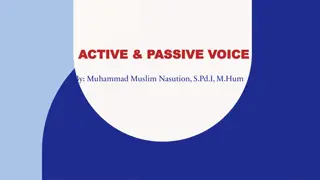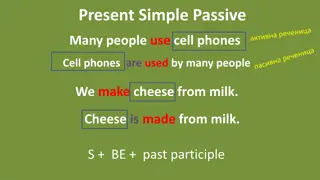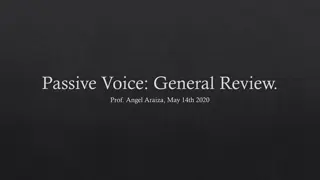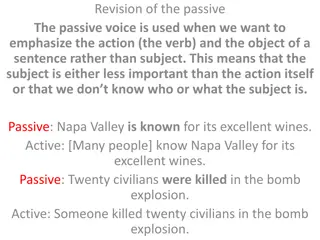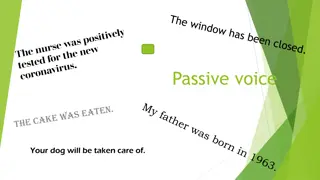Understanding Active and Passive Voice in English Grammar
Learn about active and passive voice in English grammar with clear explanations, examples, and rules. Discover how to transform sentences from active to passive voice while maintaining tense and meaning. Explore different tenses and their formations in both singular and plural contexts.
Download Presentation

Please find below an Image/Link to download the presentation.
The content on the website is provided AS IS for your information and personal use only. It may not be sold, licensed, or shared on other websites without obtaining consent from the author. Download presentation by click this link. If you encounter any issues during the download, it is possible that the publisher has removed the file from their server.
E N D
Presentation Transcript
Content Prepared by Ms. C. SASIKALA Assistant Professor, Department of English, Jamal Mohamed College, Trichy 620 020.
ACTIVE VOICE If the subject is the doer of the action, the sentence is in active voice. Eg: Rama kills a snake PASSIVE VOICE If something is done by the subject, the sentence is in passive voice Eg: A snake is killed by Rama
RULES: The subject in the active voice becomes the object in the passive voice. ii) The object in the active voice becomes the subject in the passive voice. iii)Preposition by is used in the passive voice to give complete sense to the sentence. iv) You should not change the tense. The meaning of the sentence does not change in the other voice. i) v)
ACTIVE VOICE PASSIVE VOICE I ME WE US YOU YOU THEY THEM HE HIM SHE HER IT IT
TENSE SINGULAR PLURAL PRESENT TENSE IS ARE PAST TENSE WAS WERE FUTURE TENSE WILL WILL PRESENT CONTINUOUS IS BEING ARE BEING PAST CONTINUOUS WAS BEING WERE BEING PRESENT PERFECT HAS HAVE PAST PERFECT HAD HAD FUTURE PERFECT WILL HAVE WILL HAVE
TENSE FORMATION SIMPLE PRESENT TENSE Singular --- He sees the picture (AV) The picture is seen by him (PV) Plural --- He sees the pictures. (AV) The pictures are seen by him.(PV)
PRESENT CONTINUOUS TENSE Singular ---- I am reading a book. (AV) A book is being read by me. (PV) Plural---- I am reading books. (AV) Books are being read by me. (PV) PRESENT PERFECT TENSE Singular --- He has done the job. (AV) The job has been done by him. (PV) Plural ---- They have seen the papers. (AV) The papers have been seen by them. (PV)
SIMPLE PAST TENSE Singular ----She finished her work. (AV) Her work was finished by her. (PV) Plural --- She finished her works. (AV) Her works were finished by her. (PV) PAST CONTINUOUS TENSE Singular --- Raj was working out exercise. (AV) Exercise was being worked out by raj. (PV) Plural --- Raj was working out exercises. (AV) Exercises were being worked out by Raj. (PV)
PAST PERFECT TENSE Singular --- They had done the project. (AV) The project had been done by them. (PV) Plural ---- They had done the projects. (AV) The projects had been done by them. (PV) SIMPLE FUTURE TENSE They will surely win the election. (AV) The election will be surely won by them. (PV)
FUTURE PERFECT TENSE Tom will have washed the car . (AV) The car will have been washed by Tom. (PV)
MODALS ACTIVE VOICE PASSIVE VOICE Can/should/could/may/mig ht +V1 Can/Should/Could/may/mig ht+ be +V3 1. I can eat ten apples. 1. Ten apples can be eaten by me 2. He would ride a bike. 2. A bike would be ridden by him.
IMPERATIVE ACTIVE VOICE PASSIVE VOICE Commands/ requests Let + Object + be + V3 1. Do the homework 1. Let the homework be done. 2. Help the poor 2. Let the poor be helped. 3. Open the window 3. Let the window be opened.
YES OR NO TYPE QUESTIONS ACTIVE VOICE PASSIVE VOICE Yes or NO type questions Helping verb + Object + V3+ by+ S? 1. Do you like coffee? 1. Is coffee liked by you? 2. Did she prepare lunch? 2. Was lunch prepared by her?
WH- TYPE QUESTIONS ACTIVE VOICE PASSIVE VOICE Wh- type questions By whom/ wh-question word + helping verb + object + V3+by+S ? 1.Who broke this chair? 1. By whom was this chair broken? 2. Where did he sell the fruits? 2. Where were the fruits sold by him? 3. Why do you drink tea? 3. Why is tea drunk by you?



